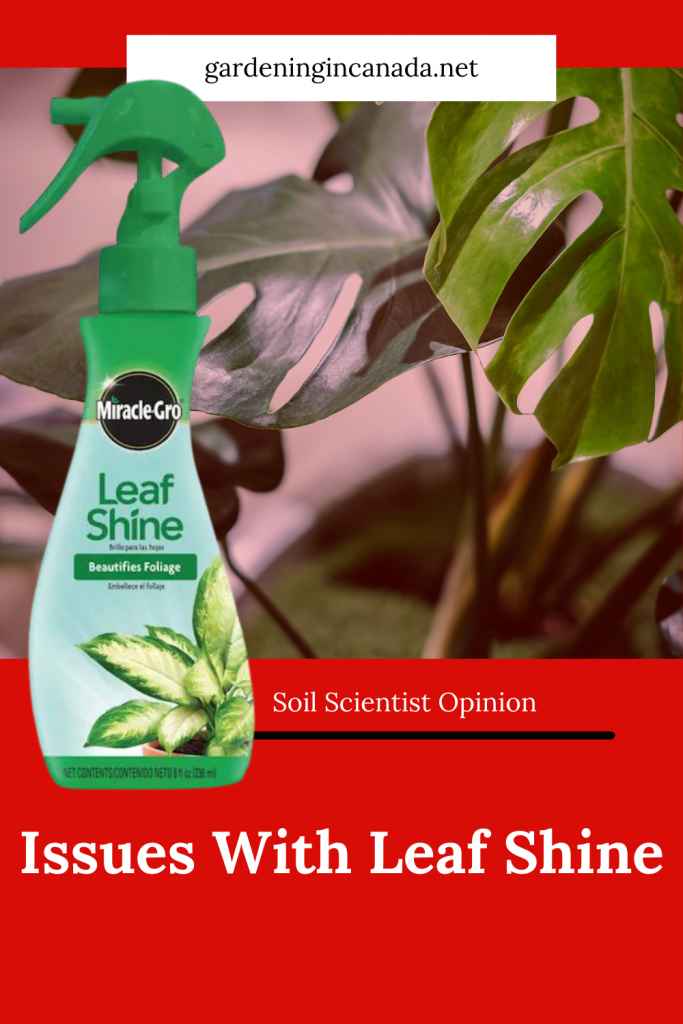- Canada’s Growing Zones Are Changing 2024 - January 12, 2024
- Attracting Wildlife To The Garden - May 16, 2023
- How To Garden Near A Septic Tank - May 9, 2023

Issues With Leaf Shine
Are you thinking about using leaf shine? The first question anyone asks when it comes to new products is what are the issues with leaf shine. This gardening in Canada blog looks at what exactly is inside of leaf shine, alternatives & how to apply.
If you are new to this blog my name is Ashley and I am a soil scientist. I am located in a Canadian Zone 3 and a USDA Zone 4. I write articles, make YouTube videos, Instagram & Facebook posts all designed for Canadians and Cold Climate gardeners using science-based methods. If you are looking for anything specific be sure to let me know in the comments down below.
The Benefits Of Leaf Shine
Leaf shine claims to do a lot of different things. From that ability to remove dust, dirt, and lime deposits to helping increase respiration and decreasing evaporation. With claims like that, you would think that there is value in adding leaf shine to a plant routine.
Does Leaf Shine Clog Pores
The claim that most of the internet makes is that leaf shine clogs pores. By pores, it is likely that they are suggesting the stomata of the leaves are becoming clogged. If the stomata of the leaves are harmed the plant is unable to respire.
The process of respiration is meant for allowing CO2 into the plant. Plants need CO2 for photosynthesis and therefore energy. If the stomata are clogged CO2 is not allowed into the plant.
Finding out if leaf shine clogs leaves is difficult without a microscope. A microscope would show if the stomata are blocked by the addition of leaf shine. The next obvious choice would be looking at the ingredients.
Powered by RedCircle
Ingredients In Leaf Shine
There are no ingredients listed on the leaf shine packaging so it is difficult for me to say if it does cause clogging. If the product contains water and a mild surfactant or alcohol it is unlikely to cause any issues. However, if the product contains any sort of parabens or oils it could cause clogging.
One of the most bizarre leaf shine is Mayo check out that article here.
How To Test Your Leaf Shine To See If It’s Bad
- Spraying some onto the back of your hand
- Allow it too dry
- Feels dry and normal it is likely just water and alcohol.
- Forms a tight feeling and dull in appearance it is likely water and a surfactant.
- Tacky and appears shiny it is likely water and a paraben of some sort.
- Shiny or oily and is not drying it is likely water, oil, and a surfactant.
Water and alcohol is the safest option when it comes to a leaf shine. If you have a water and surfactant mixture you want to make sure it is not applied to the bottoms of the leaves. If you have a paraben or surfactant mixture you may want to consider switching it out for something else.
Needless to say, the product contains more than just water because there are plenty of restrictions on what it should and should not be used on.
What Should You Not Use Leaf Shine On?
On the packing of most leaf shines I looked at there were some clear messages about what not to use the product on. Let’s review what plants you should not apply leaf shine to and why.
Monocots
A monocot is a plant with parallel leaf veins. This includes snake plants, dracaena, and palms. This is because the stomata on these plants are not limited to just one side of the leaf. They are spread evenly across both sides.
This means if the leaf shine is applied (regardless of what’s in it) you will have blocked stomata. The only form of leaf shine that should be used on a monocot plant is water.
Fuzzy Plants
Fuzzy plants such as African violets should not have leaf shine applied. Or any form of spray besides water for that matter. The fuzzy bits are called trichomes and they serve the purpose of repelling water, sunscreen, and even pest management.
If these are sprayed with an alcohol-based leaf polish it is likely to dehydrate them. If sprayed with oil or surfactant it will likely decrease much-needed airflow over the surface of the leaf.
Ferns Plant
This has to do more with the reproductive features of ferns. Ferns reproduce asexually via pores like organs on the bottoms of the leaves. These obviously should not be sprayed.
Are you thinking about using leaf shine? The first question anyone asks when it comes to new products is what are the issues with leaf shine. This gardening in Canada blog looks at what exactly is inside of leaf shine, alternatives & how to apply.
